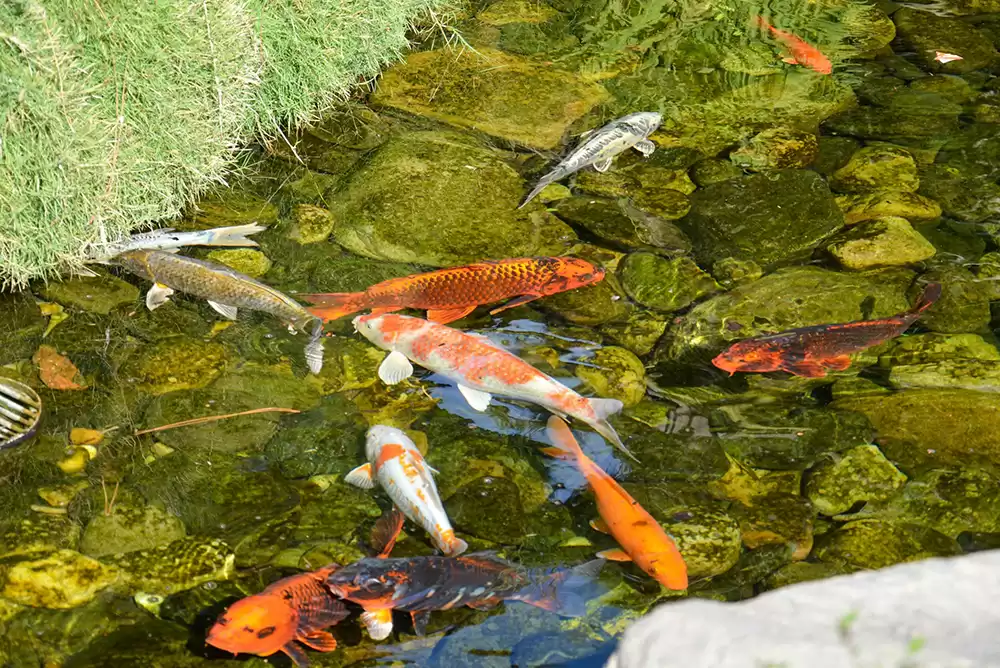
01 Oct How Does pH Affect Aquatic Pond Plants?
Maintaining a healthy and vibrant koi pond is not just about adding the right plants and fish but also about ensuring optimal water quality. One of the most crucial aspects of water quality is the pH level, which directly impacts the health of your aquatic plants. Understanding how pH affects your pond ecosystem can help you create a thriving environment for both plants and fish.
Introduction to pH and Its Importance in Ponds
pH measures how acidic or alkaline the water in your pond is, with a scale ranging from 0 to 14. A pH of seven is neutral, while values below seven indicate acidity and above seven indicate alkalinity. Maintaining the proper pH balance for aquatic pond plants is essential because it influences everything from nutrient availability to overall plant health. A well-balanced pH supports a stable ecosystem, ensuring that your plants can grow and flourish.
Ideal pH Range for Aquatic Pond Plants
Most aquatic plants thrive in a pH range of 6.5 to 7.5. This slightly acidic to neutral range is ideal because it mimics the natural conditions in which many pond plants have evolved. A pH within this range ensures that nutrients in the water are available to the plants in the right amounts, promoting healthy growth and vibrant colors.
Effects of Low pH (Acidic Conditions) on Pond Plants
When the pH of your pond water drops below 6.5, it becomes increasingly acidic. Acidic conditions can harm aquatic plants in several ways. Low pH can cause essential nutrients like calcium, magnesium, and potassium to become less available, leading to deficiencies that stunt plant growth. Also, highly acidic water can damage plant tissues, resulting in yellowing leaves, slowed growth, and increased disease susceptibility.
Effects of High pH (Alkaline Conditions) on Pond Plants
On the other end of the spectrum, a pH above 7.5 indicates alkaline conditions, which can also be detrimental to pond plants. In alkaline water, nutrients such as iron, manganese, and phosphorus can become less available, leading to similar deficiencies as in acidic conditions. This can cause the leaves of your plants to develop a pale or yellowish hue, known as chlorosis, and inhibit their ability to photosynthesize effectively.
How pH Fluctuations Affect Plant Health and Growth
pH fluctuations can be particularly harmful to aquatic plants. Rapid changes in pH can shock the plants, disrupting their ability to absorb nutrients and water. Over time, this can weaken the plants, making them more vulnerable to environmental stressors and reducing their overall vitality. Consistent pH management prevents these fluctuations and maintains a stable environment.
Impact of pH on Nutrient Availability for Pond Plants
The availability of nutrients in your pond is directly linked to the pH of the water. For instance, at a pH of 6.5 to 7.5, most nutrients are readily available to plants. However, certain nutrients can become locked up and unavailable outside of this range or reach toxic levels. Proper pH management ensures that your plants can access the right nutrients at the right time, supporting healthy growth and development.
Signs of pH Imbalance in Aquatic Pond Plants
Recognizing the signs of pH imbalance in your pond plants can help you take corrective action before severe damage occurs. Common signs include yellowing or browning of leaves, stunted growth, wilting, and an overall decline in plant vigor. If you notice any of these symptoms, you must test your pond’s pH and take steps to correct any imbalances.
Testing and Monitoring Pond pH Levels
Regularly testing your pond’s pH is critical to maintaining a healthy ecosystem. pH testing kits are widely available and easy to use, providing accurate readings of your pond’s current pH level. Monitoring pH levels weekly, especially during the growing season, can help you catch any fluctuations early and adjust as needed.
Methods to Adjust pH Levels in a Pond
If your pond’s pH is outside the ideal range, there are several methods you can use to adjust it. To raise the pH, you can add substances like baking soda or crushed coral, which act as natural buffers. Peat moss or commercially available pH-lowering products can be used to lower the pH. It is essential to make adjustments gradually, as sudden changes can harm your plants and fish.
Conclusion
Maintaining the proper pH balance in your koi pond is vital for the health and vitality of your aquatic plants. By understanding how pH affects plant health and taking steps to monitor and adjust it, you can ensure that your pond remains a thriving ecosystem. Regular testing, careful adjustments, and a keen eye for the signs of pH imbalance will help you create a pond environment where your plants can flourish year-round.



